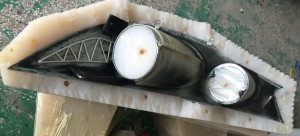Plastic Vacuum Casting
Vacuum Casting is a process for casting using a vacuum to channel the liquid material into the mold. This process is useful in the cases where air entrapment is a problem.
The process starts with the placement of silicone mold in a vacuum chamber. The raw material is mixed and degassed and poured in the mold. After this the vacuum is released and the mold is removed from the chamber. Finally it goes into an oven and the mold is removed.
This is a highly versatile technology that is capable of manufacturing parts in a variety of polyurethane (PU) resins and cast nylon and replicates engineering polymers to produce prototypes and is ideal for low volume production.
Vacuum molding is cheaper as compared to injection molding. In the initial stage of our project, when we are still not sure of things, we opt for prototypes. These prototypes offer an insight and help us to remove any defects. When we reach the early stages of production, we need more quantity of the products.
The process of vacuum casting can be compared to sipping from a straw. The molten metal is drawn into the mold in a controlled and less disturbed manner to fill the cavity. The rate of filling the cavity can be controlled. You can bring the metal slow or sometimes fast when you have to fill the thin sections.
This type of casting offers accuracy in terms of dimensions, excellent mechanical properties and a clean appearance.
When we explore options to produce a batch of products, we have to keep our requirements in mind. If aesthetics are to be kept in mind then we can go for vacuum casting or injection molding. Vacuum casting has a lower front cost with higher price for each unit. There can be modification in design with each re-tool.
Vacuum casting at torch mold allows producing high quality parts. These will replicate the injection molded parts and saves overheads and also the long lead-time.
Whether you are thinking of a consumer product, automotive lenses, under- bonnet component, housing products, enclosures, health care products, industrial products or interiors, we at torch mold have the solution. It is also possible to produce high quality wax masters used in the investment casting industry.
In the this process, the mold needs to be created first. These are formed using a master model. This master model is usually produced via 3D printing from computer aided design digital model. The best part about this service is that up to 50 parts can be produced before retooling is required.
There are various aspects that have to be kept in mind before choosing a casting material. The desired weight, appearance, durability, texture and above all the pricing have to be kept in mind.
In certain cases, the mold needs to be prepared. So it is important to select a casting method in advance so that the mold can be prepared accordingly.
By using vacuum to evacuate air in an enclosed area, metal casters can produce complex castings successfully. The objective of this method is to control the metal flow as much as possible for a tranquil mold fill.
Some of the features of this process are-
• We can increase the flow rate to fill the cavity faster than the gravity pouring thus making it easier to fill the thinner sections of casting
• When we control the flow rate, the overall metal casting soundness is improved.
• The metal is drawn from below the surface of the molten metal bath and so it avoids slag and inclusions.
• This method provides a good surface finish
• It gives superior dimensional tolerance.
• Critical metal temperature variations can be controlled easily.

